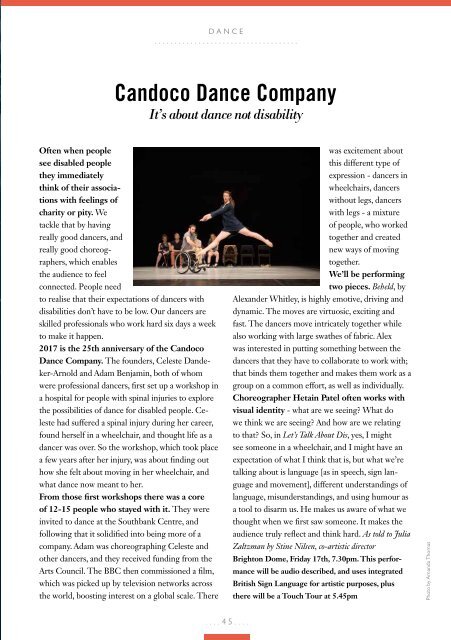Viva Brighton Issue #48 February 2017
Create successful ePaper yourself
Turn your PDF publications into a flip-book with our unique Google optimized e-Paper software.
DANCE<br />
....................................<br />
Candoco Dance Company<br />
It’s about dance not disability<br />
Often when people<br />
see disabled people<br />
they immediately<br />
think of their associations<br />
with feelings of<br />
charity or pity. We<br />
tackle that by having<br />
really good dancers, and<br />
really good choreographers,<br />
which enables<br />
the audience to feel<br />
connected. People need<br />
to realise that their expectations of dancers with<br />
disabilities don’t have to be low. Our dancers are<br />
skilled professionals who work hard six days a week<br />
to make it happen.<br />
<strong>2017</strong> is the 25th anniversary of the Candoco<br />
Dance Company. The founders, Celeste Dandeker-Arnold<br />
and Adam Benjamin, both of whom<br />
were professional dancers, first set up a workshop in<br />
a hospital for people with spinal injuries to explore<br />
the possibilities of dance for disabled people. Celeste<br />
had suffered a spinal injury during her career,<br />
found herself in a wheelchair, and thought life as a<br />
dancer was over. So the workshop, which took place<br />
a few years after her injury, was about finding out<br />
how she felt about moving in her wheelchair, and<br />
what dance now meant to her.<br />
From those first workshops there was a core<br />
of 12-15 people who stayed with it. They were<br />
invited to dance at the Southbank Centre, and<br />
following that it solidified into being more of a<br />
company. Adam was choreographing Celeste and<br />
other dancers, and they received funding from the<br />
Arts Council. The BBC then commissioned a film,<br />
which was picked up by television networks across<br />
the world, boosting interest on a global scale. There<br />
was excitement about<br />
this different type of<br />
expression - dancers in<br />
wheelchairs, dancers<br />
without legs, dancers<br />
with legs - a mixture<br />
of people, who worked<br />
together and created<br />
new ways of moving<br />
together.<br />
We’ll be performing<br />
two pieces. Beheld, by<br />
Alexander Whitley, is highly emotive, driving and<br />
dynamic. The moves are virtuosic, exciting and<br />
fast. The dancers move intricately together while<br />
also working with large swathes of fabric. Alex<br />
was interested in putting something between the<br />
dancers that they have to collaborate to work with;<br />
that binds them together and makes them work as a<br />
group on a common effort, as well as individually.<br />
Choreographer Hetain Patel often works with<br />
visual identity - what are we seeing? What do<br />
we think we are seeing? And how are we relating<br />
to that? So, in Let’s Talk About Dis, yes, I might<br />
see someone in a wheelchair, and I might have an<br />
expectation of what I think that is, but what we’re<br />
talking about is language [as in speech, sign language<br />
and movement], different understandings of<br />
language, misunderstandings, and using humour as<br />
a tool to disarm us. He makes us aware of what we<br />
thought when we first saw someone. It makes the<br />
audience truly reflect and think hard. As told to Julia<br />
Zaltzman by Stine Nilsen, co-artistic director<br />
<strong>Brighton</strong> Dome, Friday 17th, 7.30pm. This performance<br />
will be audio described, and uses integrated<br />
British Sign Language for artistic purposes, plus<br />
there will be a Touch Tour at 5.45pm<br />
Photo by Amanda Thomas<br />
....45....


















